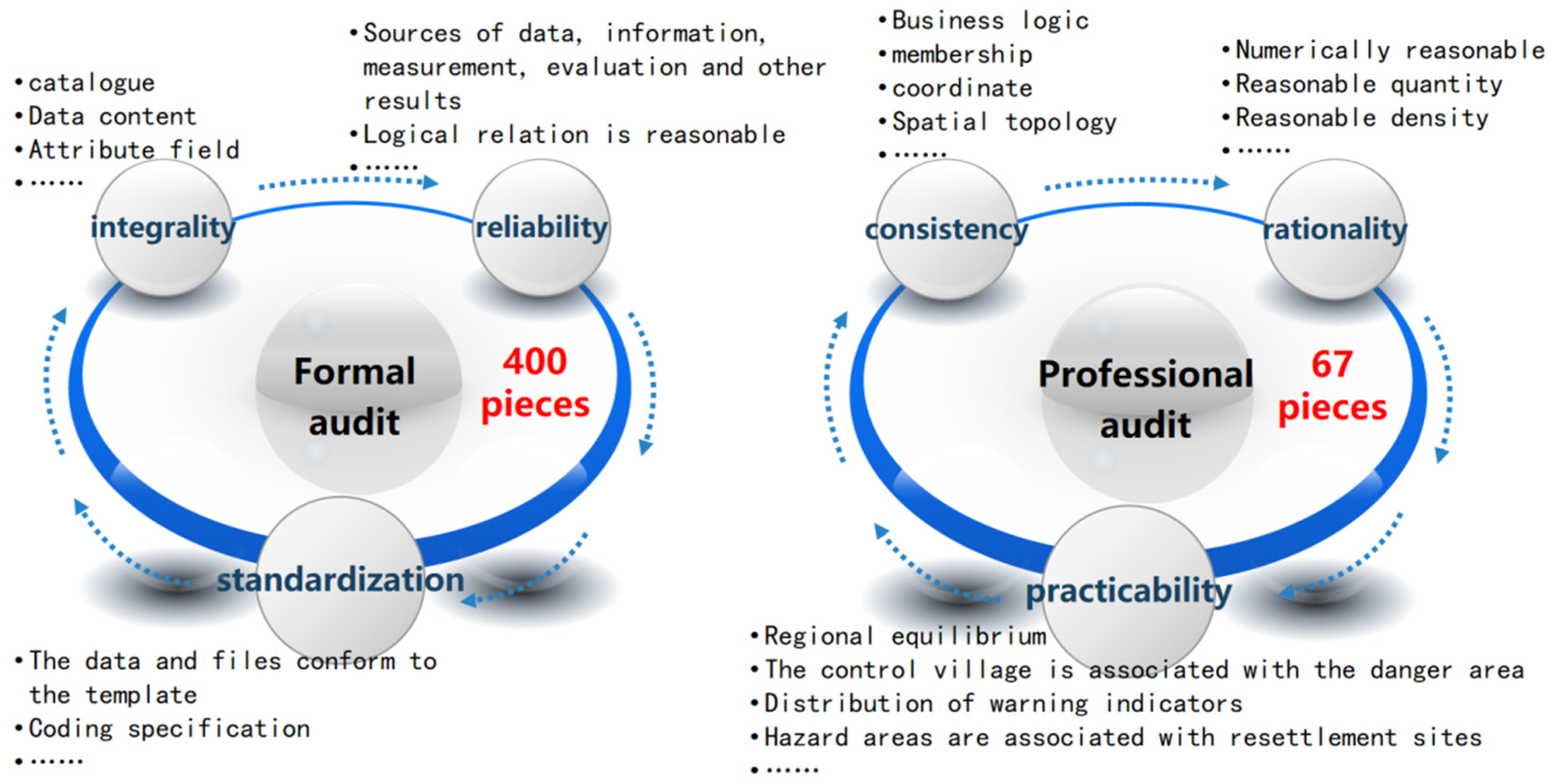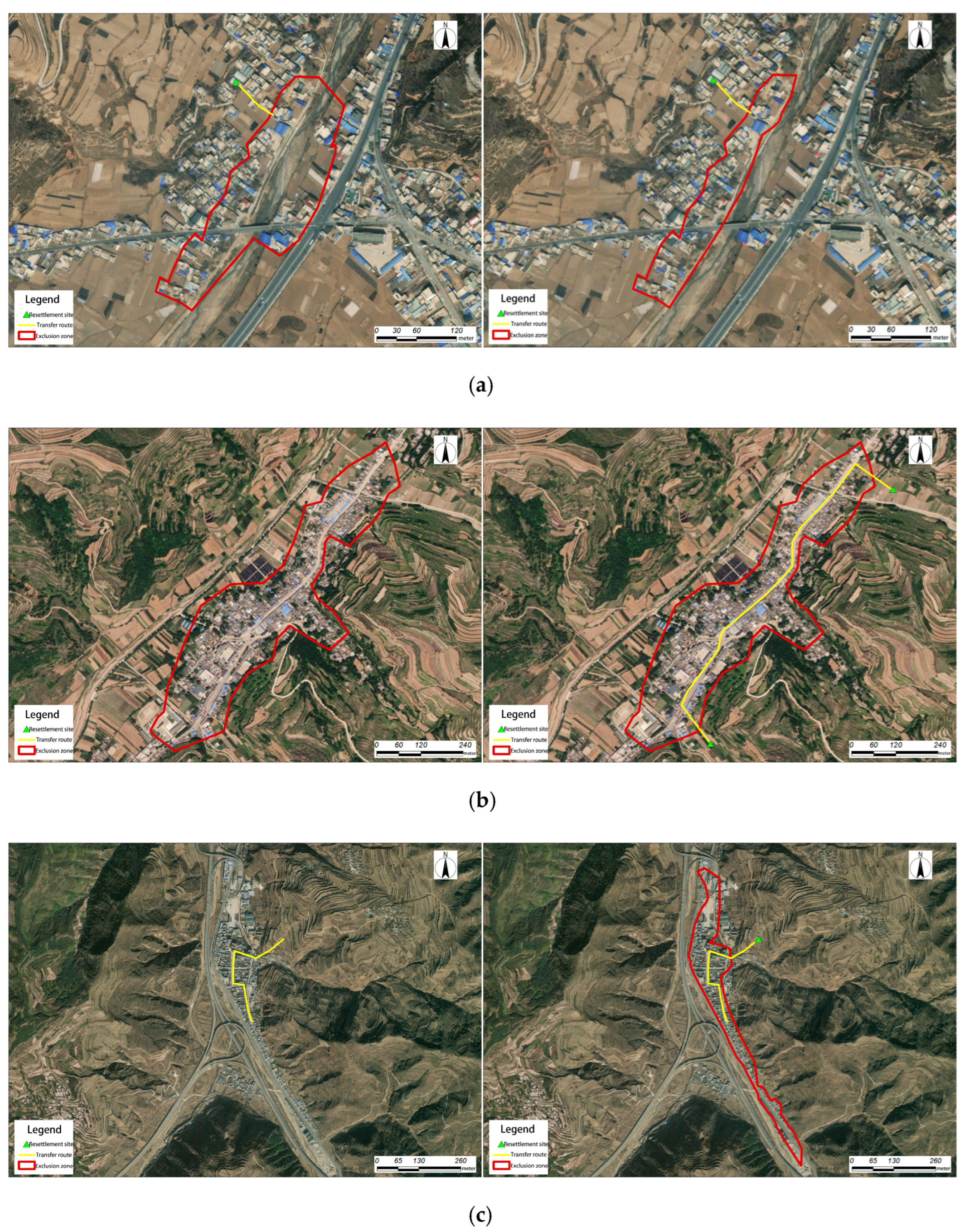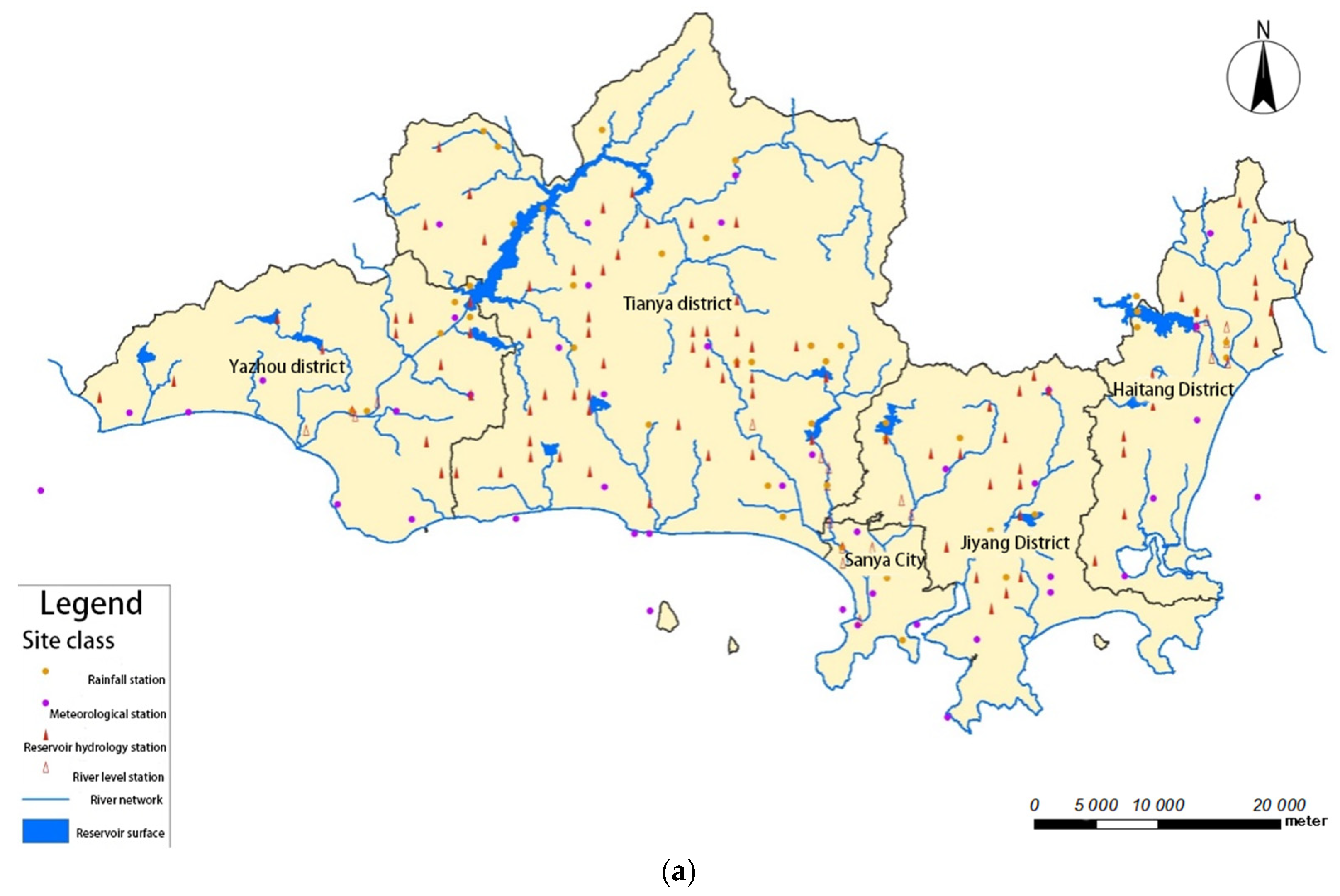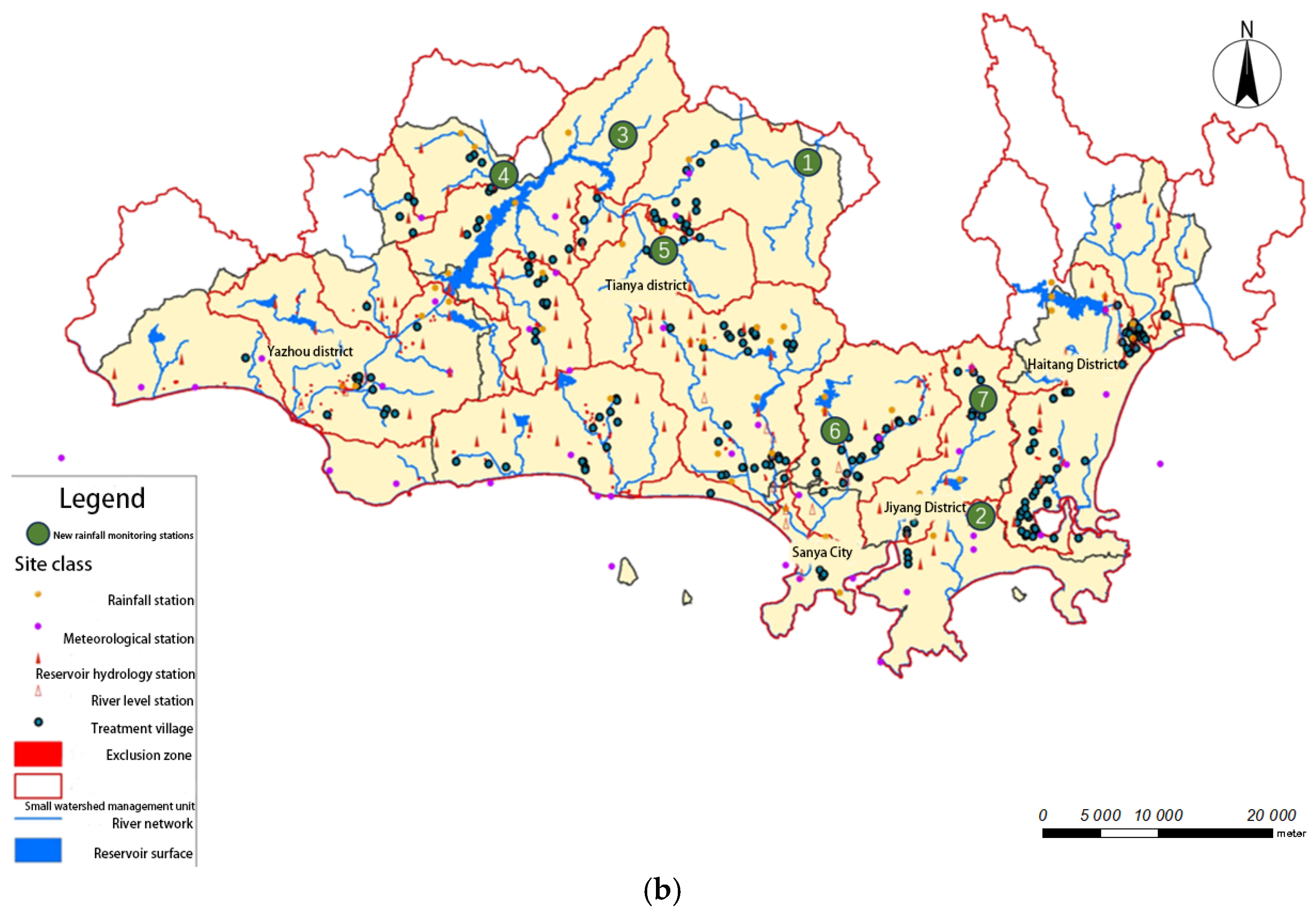Research on the Audit Rules for National Mountain Flood Disaster Survey and Evaluation Results of Key Towns and Villages
Abstract
1. Introduction
2. Methodology and Databases
2.1. Databases
2.2. Automated Software Verification
2.3. Manual Verification
2.4. Hazard Zone–Station Correlation
2.5. Topological Checking
3. Audit Principles, Contents, and Rules
3.1. Audit Principles
- (1)
- Data reception at the provincial level;
- (2)
- Formal audit;
- (3)
- Data entry and mapping;
- (4)
- Professional audit;
- (5)
- Compilation into the national-level results database;
- (6)
- Project acceptance.
3.2. Audit Contents
3.3. Audit Rules
3.3.1. Formal Audits
- (i)
- Attribute Tables
- (ii)
- Spatial data
- (1)
- Spatial data should correspond with the attribute tables (with unique matching values).
- (2)
- Spatial layers should not exceed the survey scope of the key towns and villages.
- (3)
- Spatial data should not have topological errors (overlaps, self-intersections, and gaps).
- (4)
- All latitude and longitude coordinates must be accurate to at least six decimal places.
- (iii)
- Multimedia
- (1)
- Multimedia photos should not be duplicated.
- (2)
- Multimedia photos should not be misplaced.
- (3)
- Photo-naming conventions should be followed, and index tables should be complete.
- (4)
- The multimedia attribute Table 2 should be consistent with the photo index table.
3.3.2. Professional Audits
- (i)
- Data Consistency Audits
- Business logic consistency audits examine whether the relationships among various data elements conform to the technical requirements.
- Affiliation consistency audits ensure that the spatial location of the data corresponds correctly to the administrative divisions. Regarding the point features, this step checks if they fall within the corresponding administrative area; regarding line features, this step checks if they intersect or are contained within the administrative boundaries.
- Latitude and longitude consistency audits ensure that the coordinate systems of the data are consistent.
- Spatial topology audits are performed on vector data, especially for line and polygon data. Topological errors, such as overlapping hazard zones or flood control routes, are not allowed.
- (ii)
- Data Rationality Audits
- (1)
- Numerical value rationality audits
- (2)
- Quantity rationality audits
- (iii)
- Practicality Audits
- (1)
- Regional distribution balance;
- (2)
- Correlation between prevention and control villages and hazardous hazard zones;
- (3)
- Distribution of early warning indicators;
- (4)
- Correlation between hazard zones and evacuation sites.
- (1)
- The population data are compared with the 2021 National Statistical Yearbook to identify outliers.
- (2)
- The reasonableness of the population-to-household ratios are checked, e.g., typical family households have fewer than 10 people, while hospitals and schools may have more than 100 people. In special cases, there may be no residents in livestock farming hazardous areas.
- (3)
- The population density balance is audited, comparing the town-level, county-level, and provincial-level population densities.
- (4)
- The logical consistency of the population distribution is verified, e.g., the population in hazard zones should be less than the total population, and the number of households in hazard zones should be lower than total number of households.
4. Newly Added Professional Audit Guidelines
4.1. Early Warning Indicator Analysis
- (1)
- Logical consistency: Regarding the same warning level, 1-h < 3-h, 3-h < 6-h, and villages < towns. In the same region, the warning level should be logically reasonable under very dry, moderate, and very moist soil conditions.
- (2)
- Comparison of early warning indicators with the design cloudburst: The early warning indicators for 1, 3, and 6 h are compared for different recurrence intervals (5, 10, 20, 50, and 100 years). More attention should be paid to the early warning indicators for return periods less than 5 years and more than 50 years.
- (3)
- Comparison with the flood control capacity: Early warning indicators should not exceed the flood control capacity; otherwise, the early warning indicator setting may be unreasonable.
- (4)
- Comparison of similar small watershed management units: The results of early warning indicators are compared and analyzed in the small watersheds that share similar characteristics, including geometric features, climate conditions, topography, land use and vegetation types, soil texture, and flood discharge capacity. If the early warning indicators of similar watersheds differ significantly, these indicators may be unreasonable.
- (5)
- Comparison of upstream and downstream towns and villages: The topological relationships among key towns and villages along the river system are established according to the operational requirements of flash flood disaster prevention, and comparison of the early warning indicators in these areas should be consistent and reasonable.
- (6)
- Comparison with actual local flash flood disaster records: The indicators are analyzed and compared with real-world data on flash flood disaster events in the local area.
- (7)
- Cross-analysis of results from various methods: Comparative analyses are conducted on the results obtained with different methods.
4.2. Hazard Zone Classification
- (1)
- The scope of the hazard zone is unreasonable (cutting through houses, spanning rivers, etc.);
- (2)
- There is a standalone hazard zone without evacuation routes or shelter locations;
- (3)
- The starting point of the evacuation route is not connected to the hazard zone (i.e., they are relatively far apart);
- (4)
- The evacuation route does not follow roads, cuts through houses, or crosses rivers;
- (5)
- There are evacuation routes without connected hazard zones or shelter locations;
- (6)
- The shelter location is unreasonable, either still within the hazard zone or too far away;
- (7)
- There is a shelter location without a hazard zone or evacuation routes.
4.3. Monitoring Facility Analysis
- (1)
- Monitoring stations should be located in the upper or middle reaches of watersheds with key towns or in their upstream areas.
- (2)
- Stations should be within a 5 km radius.
- (3)
- A single monitoring station may serve multiple key towns.
- (4)
- A single key town may be associated with multiple monitoring stations.
- (5)
- Coordination should be achieved among flood, hydrological, meteorological, and reservoir stations within the watershed.
- (6)
- Effective relationships should be established among the stations, early warning indicators, protection targets, and small watersheds.
5. Discussion
6. Conclusions
Author Contributions
Funding
Data Availability Statement
Conflicts of Interest
References
- Stamos, I.; Diakakis, M. Mapping Flood Impacts on Mortality at European Territories of the Mediterranean Region within the Sustainable Development Goals (SDGs) Framework. Water 2024, 16, 2470. [Google Scholar] [CrossRef]
- Nederhoff, K.; Crosby, S.C.; Van Arendonk, N.R.; Grossman, E.E.; Tehranirad, B.; Leijnse, T.; Klessens, W.; Barnard, P.L. Dynamic Modeling of Coastal Compound Flooding Hazards Due to Tides, Extratropical Storms, Waves, and Sea-Level Rise: A Case Study in the Salish Sea, Washington (USA). Water 2024, 16, 346. [Google Scholar] [CrossRef]
- Guo, L.; Ding, L.; Kuang, S.; Wang, X.; Sun, D.; Li, C.; Xie, J.; Liu, C.; He, B.; Liu, R.; et al. Key Technologies and Applications for Investigation and Evaluation of Flash Flood Disasters in China. China Flood Control Drought Relief 2018, 28, 7–11+32. [Google Scholar]
- Yin, Y.; Peña, M. An Imputing Technique for Surface Water Extent Time Series with Streamflow Discharges. Water 2024, 16, 250. [Google Scholar] [CrossRef]
- Guo, J. Survey and Evaluation Methods of Mountain Flood Disaster and Analysis of Quality Control Measures in Beizhen City. Undergr. Water 2018, 40, 211–212. [Google Scholar] [CrossRef]
- Feng, A.; Guo, M.; Lv, Z. Methods and Procedures for Investigation and Evaluation of the “Three Rates” (Recovery Rate, Utilization Rate, and Comprehensive Utilization Rate) of Important Mineral Resources in China. Mineral Resources Protection and Utilization. 2016. Available online: www.minerals.com (accessed on 12 February 2025).
- Porębska, A.; Muszyński, K.; Godyń, I.; Racoń-Leja, K. City and Water Risk: Accumulated Runoff Mapping Analysis as a Tool for Sustainable Land Use Planning. Land 2023, 12, 1345. [Google Scholar] [CrossRef]
- Antwi-Agyakwa, K.T.; Afenyo, M.K.; Angnuureng, D.B. Know to Predict, Forecast to Warn: A Review of Flood Risk Prediction Tools. Water 2023, 15, 427. [Google Scholar] [CrossRef]
- Zhu, X.; Xiao, B. Preliminary Exploration of Dynamic and Hierarchical Management of Flash Flood Hazard Zones in Sichuan Province. China Flood Control Drought Relief 2021, 3, 20–22+33. [Google Scholar] [CrossRef]
- Manfreda, S.; Samela, C.; Refice, A.; Tramutoli, V.; Nardi, F. Advances in Large-Scale Flood Monitoring and Detection. Hydrology 2018, 5, 49. [Google Scholar] [CrossRef]
- Scholz, M.; Yang, Q. Novel Method to Assess the Risk of Dam Failure. Sustainability 2011, 3, 2200–2216. [Google Scholar] [CrossRef]
- Ye, J.; Bai, Y.; Xu, J.; Huang, S.; Han, Z.; Wan, W. Public Authentic-Replica Sampling Mechanism in Distributed Storage Environments. Electronics 2024, 13, 4167. [Google Scholar] [CrossRef]
- Wei, X. Supporting Refined Management through Hazard Zone Classification and Gaining Proactive Prevention through Progressive Warnings. China Water Resources News, 6 July 2023. [Google Scholar] [CrossRef]
- Sanda, M.-R.; Siminică, M.-I.; Avram, C.-D.; Popescu, L. Ghosts in the Machine: How Big Data Analytics Can Be Used to Strengthen Online Public Procurement Accountability. Sustainability 2024, 16, 3698. [Google Scholar] [CrossRef]
- Zhang, P.; Sun, X.; Peng, H. Summary and Suggestions on Integration and Review of Mountain Flood Disaster Investigation and Evaluation in Guangdong Province. China Flood Drought Manag. 2019, 29, 20–23. [Google Scholar]
- Zhou, D.; Lu, G.; Jiang, Z. Research on Quality Control of Mountain Flood Disaster Investigation and Evaluation Results in Liaoning Province. Flood Control Drought Relief China 2017, 27, 64–66. [Google Scholar] [CrossRef]
- Wang, D.; Yuan, S.; Yang, C.; Zhu, X.; Luo, L. Summary of Investigation and Evaluation of Mountain Flood Disaster in Yunnan Province. Flood Control Drought Relief China 2018, 28, 40–43+47. [Google Scholar] [CrossRef]
- Yao, L.L. Application of Information Technology in Mountain Flood Disaster Investigation and Evaluation. Appl. Technol. Soil Water Conserv. 2017, 3, 25–27. [Google Scholar]
- Feng, A.-S.; Guo, M.; Lu, Z. Methods and procedures of “three rates” survey and evaluation of national important mineral resources. Miner. Prot. Util. 2016, 5, 1–4. [Google Scholar] [CrossRef]
- Que, B.M. Research on Implementation and Management of Mountain Flood Disaster Prevention Project in Guangxi. Master’s Thesis, Guangxi University, Nanning, China, 2014. (In Chinese). [Google Scholar]
- Yao, C. Summary analysis of mountain flood disaster investigation, evaluation and review in Hebei. Inn. Mong. Water Resour. 2019, 6, 59–60. [Google Scholar]
- Li, H. Design of data review and collection system for mountain flood disaster investigation and Evaluation. J. Inn. Mong. Univ. Natl. 2016, 31, 213–215. [Google Scholar] [CrossRef]
- Huang, X.; Chu, M.; Shi, J. Analysis on investigation and evaluation of mountain flood disaster in China. China Water Resour. 2015, 9, 17–18+29. [Google Scholar]
- An, T.-H. Five Achievements helping to upgrade the level of mountain flood disaster prevention and control: An overview of the results of the national Mountain Flood Disaster investigation and evaluation project. China Water Resour. 2019, 3, 6–11. [Google Scholar]
- Liu, D. Bei Town city mountain torrent disaster survey evaluation audit analysis. J. Heilongjiang Prov. Water Conserv. Sci. Technol. 2018, 46–48, 180–181. [Google Scholar]
- Liu, Y.S. Evaluation of Spatial and Temporal Distribution Pattern and Driving Force Heterogeneity of Mountain Flood Disasters in China. Ph.D. Thesis, Tianjin University, Tianjin, China, 2017. [Google Scholar]






| Serial Number | Table Name | Serial Number | Table Name |
|---|---|---|---|
| 1 | Analyzing the evaluation directory | 9 | Hazardous area basics |
| 2 | Designing for rainstorms | 10 | Historical flash floods |
| 3 | Control section design flood | 11 | Automatic monitoring stations, wireless early warning broadcasting stations, simple rainfall stations, simple rainfall stations |
| 4 | Evaluation of the current state of flood control | 12 | Reservoirs, sluices, embankments, ponds (weirs), and dam works in the control area |
| 5 | Critical rainfall empirical estimation method, critical rainfall analysis method, critical rainfall modeling analysis method results (1 of 3) | 13 | Road culvert and bridge works |
| 6 | Early warning indicators | 14 | Survey of residents of important towns and cities |
| 7 | General information on administrative divisions | 15 | Multimedia |
| 8 | Basic information on the prevention and control area | 16 | Ditch longitudinal cross-section, historical flood scar measurement |
| Serial Number | Chinese Name | Serial Number | Chinese Name |
|---|---|---|---|
| 1 | Administrative subdivision (e.g., map layer) | 12 | Simple water level station layer |
| 2 | Residential settlement contour layer | 13 | Layer of pond (weir) project |
| 3 | Enterprise layers | 14 | Road culvert engineering layers |
| 4 | Hazardous area layer | 15 | Bridge engineering layers |
| 5 | Settlement layer | 16 | Reservoir engineering layers |
| 6 | Transfer roadmap layer | 17 | Layers for sluice gate engineering |
| 7 | Historical flash flood layers | 18 | Embankment engineering layers |
| 8 | Layers of flood management gullies in need of flood control | 19 | Layer of households in important urban agglomerations |
| 9 | Automatic monitoring station layer | 20 | Trench longitudinal section layer |
| 10 | Wireless early warning broadcasting station layer | 21 | Trench cross-section layer |
| 11 | Simple rainfall station layer | 22 | Historical flood trace measurement points layer |
| Analysis of Early Warning Indicators | National Average Problem Detection Rate | Highest Problem Detection Rate by Province | ||||||
|---|---|---|---|---|---|---|---|---|
| Before an Audit | After an Audit | Difference (Result of Subtraction) | Before an Audit | After an Audit | Difference (Result of Subtraction) | |||
| Logical Relationship is Reasonable | 4% | 0% | 4% | 22% | 0% | 22% | ||
| Comparison with design storm | 1 h Early warning indicators | Less than 5 years | 57% | 52% | 5% | 96% | 76% | 20% |
| 50 years or more | 4% | 5% | 1% | 0% | 16% | 16% | ||
| 3 h Early warning indicators | Less than 5 years | 36% | 34% | 2% | 24% | 7% | 18% | |
| 50 years or more | 4% | 6% | 2% | 6% | 17% | 11% | ||
| 6 h Early warning indicators | Less than 5 years | 31% | 30% | 1% | 57% | 39% | 18% | |
| 50 years or more | 4% | 6% | 2% | 1% | 20% | 19% | ||
Disclaimer/Publisher’s Note: The statements, opinions and data contained in all publications are solely those of the individual author(s) and contributor(s) and not of MDPI and/or the editor(s). MDPI and/or the editor(s) disclaim responsibility for any injury to people or property resulting from any ideas, methods, instructions or products referred to in the content. |
© 2025 by the authors. Licensee MDPI, Basel, Switzerland. This article is an open access article distributed under the terms and conditions of the Creative Commons Attribution (CC BY) license (https://creativecommons.org/licenses/by/4.0/).
Share and Cite
Xie, M.; Qi, S.; Dou, Y.; Zhang, X. Research on the Audit Rules for National Mountain Flood Disaster Survey and Evaluation Results of Key Towns and Villages. Water 2025, 17, 773. https://doi.org/10.3390/w17060773
Xie M, Qi S, Dou Y, Zhang X. Research on the Audit Rules for National Mountain Flood Disaster Survey and Evaluation Results of Key Towns and Villages. Water. 2025; 17(6):773. https://doi.org/10.3390/w17060773
Chicago/Turabian StyleXie, Min, Shuwen Qi, Yanhong Dou, and Xiaolei Zhang. 2025. "Research on the Audit Rules for National Mountain Flood Disaster Survey and Evaluation Results of Key Towns and Villages" Water 17, no. 6: 773. https://doi.org/10.3390/w17060773
APA StyleXie, M., Qi, S., Dou, Y., & Zhang, X. (2025). Research on the Audit Rules for National Mountain Flood Disaster Survey and Evaluation Results of Key Towns and Villages. Water, 17(6), 773. https://doi.org/10.3390/w17060773







